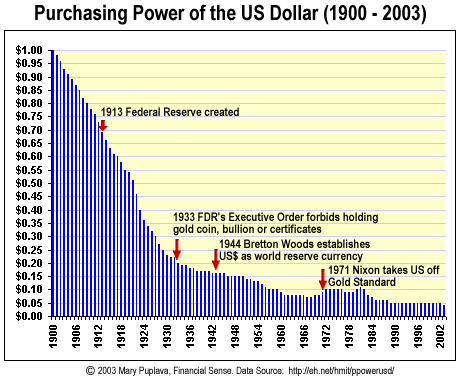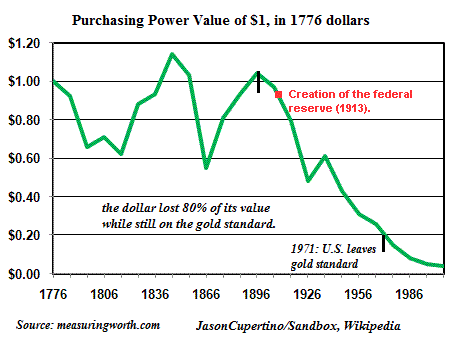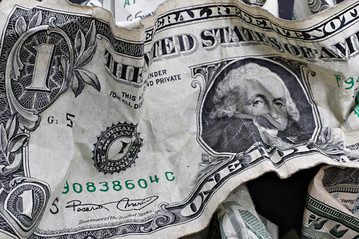The conventional view looks at the domestic credit bubble, the trillions in derivatives and the phantom assets propping the whole mess up and concludes that the only way out is to print the U.S. dollar into oblivion, i.e. create enough dollars that the debts can be paid but in doing so, depreciate the dollar’s purchasing power to near-zero.This process of extravagant creation of paper money is also called hyper-inflation. While it is compelling to see hyper-inflation as the only way out in terms of the domestic credit/leverage bubble, the dollar has an entirely different dynamic if we look at foreign exchange (FX) and foreign trade. Words: 1675
and the phantom assets propping the whole mess up and concludes that the only way out is to print the U.S. dollar into oblivion, i.e. create enough dollars that the debts can be paid but in doing so, depreciate the dollar’s purchasing power to near-zero.This process of extravagant creation of paper money is also called hyper-inflation. While it is compelling to see hyper-inflation as the only way out in terms of the domestic credit/leverage bubble, the dollar has an entirely different dynamic if we look at foreign exchange (FX) and foreign trade. Words: 1675
So says Charles Hugh Smith in edited excerpts from his original article* as posted at www.oftwominds.com.
Lorimer Wilson, editor of www.munKNEE.com (Your Key to Making Money!) and www.FinancialArticleSummariesToday.com (A site for sore eyes and inquisitive minds) has edited the article below for length and clarity – see Editor’s Note at the bottom of the page. This paragraph must be included in any article re-posting to avoid copyright infringement.
Smith goes on to say, in part:
To What Extent has the Purchasing Power of the U.S. Dollar Declined Over the Years?
Many analysts fixate on monetary policy as if it and the relationship of gold to the dollar are the foundation of our problems. These analysts often pinpoint the 1971 decision by President Nixon to abandon the gold standard as the start of our troubles. That decision certainly had a number of consequences, but 80% the dollar’s loss of purchasing power occurred before the abandonment of dollar convertibility to gold. As seen in the chart below the depreciation from 1971 on looks rather modest. Clearly, dropping the convertibility of the dollar to gold did not change the overall depreciation dynamic much; the dollar had been losing purchasing power since the turn of the century.
Below is the dollar’s purchasing power plotted by another source. Note how the purchasing power fluctuated significantly in the 19th century. The emergence of the (privately owned) Federal Reserve as the issuer of the dollar accelerated the dollar’s depreciation–a decline interrupted only by the deflationary Great Depression.
To understand the dollar’s primary role as a means of exchange for trade, let’s start with the relative size of the foreign exchange market. The FX markets trade some $2 trillion a day, far larger than either the credit or stock markets. It is quite miraculous when you think about it. We print some symbols and images on a piece of paper, and we can exchange that intrinsically worthless paper for real goods and materials: oil, electronics, vehicles, and so on. That magic privilege is certainly worth maintaining.
Why Would Anyone Trade Real Tangible Wealth (say, oil) for Specially Printed Paper?
There are basically three reasons:
- They can use the paper to buy goods and services from other nations.
- They can buy bonds with the paper money that will draw interest and be paid as promised.
- When the money is withdrawn to exchange for goods and services, it has retained the vast majority of the purchasing power it held when deposited.
If we look at the charts above, we might ask why would anyone accept U.S. dollars (USD) as payment for real goods when it so steadily loses purchasing power? The answer can be found by re-reading the three conditions above:
- if the USD draw interest, and that income is larger than the loss of purchasing power, then the money will still retain its purchasing power when withdrawn.
For instance, if the USD deposits draw 5% annual interest and the USD loses 3% of purchasing power every year, the owner of the dollar still earned a 2% positive return.
There is another interesting feature of interest-bearing bonds:
- as interest rates decline, the bond rises in value.
This sets up the delicious irony of the Chinese whining about their $1 trillion in U.S. Treasury bonds earning such low yields, while in fact their holdings have greatly increased in value as interest rates have declined.
What Underpins a Fiat Currency’s Purchasing Power?
Ultimately, the value of any paper (free-floating) currency is based on the issuer’s ability to enforce claims on reliably stable income streams and assets.
- Any nation that promises to pay interest on bonds denominated in its currency must be able to enforce its claim on the national income via taxation.
- If the national income is too unreliable or unstable to support the claim, the international community loses faith in the currency and it depreciates to zero even if the currency isn’t printed with abandon.
In other words, the value of the currency as an international means of exchange is not just a function of monetary policy or money supply; the market “prices” a free-floating currency on a number of factors, all related to the three above points.
Why Did the U.S. Go Off the Gold Standard?
The key to understanding Nixon’s decision to break the international convertibility of the dollar to gold was the transition of the U.S. from a net exporter to a net importer. Once U.S. domestic oil production peaked and it became necessary to import oil, the U.S. became a net importer in a deeply structural sense. With the dollar convertible to gold, eventually the exporting nations would have ended up with all the U.S.’s gold, and that was not going to happen.
Take Note:
The solution was to float the dollar and trade paper money for the oil but the magic of trading paper for oil could only be maintained if the paper retained the vast majority of its purchasing power over typical investment timeframes. In this, the U.S. held the immense advantage of issuing the reserve currency, i.e. paper money accepted globally for payment of debts, but this privilege was not magic; the currency still had to reliably draw interest and retain its purchasing power.
Ultimately, the USD retains its value based on the U.S. government’s claim to the nation’s immense income stream, its assets and its ability to attract international capital.
How Does the Market “Price” a Currency?
We can understand the market’s “pricing” of these variables by asking: if we had to hold a currency for trading purposes, i.e. to settle debts resulting from global trade, and we needed to hold some of that currency for five years, which currency would be most likely to retain its purchasing power, based on the income stream, assets and capital flows of the issuing nation?This question illuminates the varied nature of assets. Yes, gold and oil are assets; but so is enabling the free flow of international trade, for example.
We can ask the question somewhat differently: is it within the power of the currency’s issuer to mandate its purchasing power five years hence? How much of the market’s “pricing” is outside the control of the issuer? Let’s take a look at a few examples.
The euro: Does anyone seriously believe the European Central Bank (ECB) retains sufficient global control over the euro’s valuation to mandate its value five years hence? The currency’s viability is in question even now, never mind in five years. Clearly, much of the market’s pricing of the euro’s value is outside the control of the euro’s issuers; whether they admit it or not is irrelevant.
The Chinese yuan/renminbi: In a similar fashion, China dares not let the renminbi float lest the market “price in” the instabilities implicit in China’s economy and trade. If we were able to tote up true capital flows out of China, it is entirely possible that capital flows have reversed, and more capital is flowing out of China into the U.S. than is flowing from the U.S. to China. If we don’t understand capital flows are assets, then we understand neither capital flows nor what constitutes an asset.
The Japanese yen: The yen is currently viewed as a “safe haven” due to the great stability and wealth of Japan. Two decades of massive deficit spending and debt accumulation, however, are finally putting pressure on Japan, Inc., and those willing to bet the yen will retain its current purchasing power for five more years are taking on an extraordinary amount of risk that has yet to be priced into the yen.
Once again, the question boils down to how much of the yen’s purchasing power is in the hands of its issuers. For 20 years, Japan’s domestic purchases of its own debt kept the global market at bay. As domestic savings rates dry up and the ageing Baby Boomers start cashing in their bonds and drawing pensions, the system may finally be exposed to global market “pricing” of risk. That exposure could destabilize the yen’s position as “safe haven.”
The U.S. dollar: Whatever your calculus, it is self-evident that of all the issuers of major currencies, the U.S. retains the most control over the elements the market uses to “price” the risk that the dollar’s value as a means of exchange and store of value is unsettled.
Another way to understand the market’s valuation of the dollar, and any other floating currency, [is to determine the extent to which]…you can buy in the issuer’s nation with its paper money. If restrictions on foreign ownership crimp what you can buy, the currency’s value reflects that. If there is relatively little of value to buy, or the risks of ownership are high, then once again the market will mark down the “price” of that currency.
Despite its myriad problems and challenges, the U.S. allows a fairly broad range of foreign ownership of land, corporations, etc. If you have surplus dollars, you can buy property or an oil well in the U.S. It may not produce much oil, but the output can be sold domestically and its value is relatively easy to calculate. The U.S. economy is vast and there’s a wide variety of things and assets to buy with your dollars. In other words, there is a vast market that will accept your dollars in exchange for tangible goods and assets.
Conclusion
The U.S. dollar has reversed its long downtrend and is now in a structural advance. If we examine the multiple dynamics of FX, foreign trade and the market’s pricing of currencies, we can discern a strong fundamental case for this advance as well…
*www.oftwominds.com/blogjuly12/dollar-safe-haven7-12.html (To access the above article please copy the URL and paste it into your browser.)
Editor’s Note: The above article may have been edited ([ ]), abridged (…), and reformatted (including the title, some sub-titles and bold/italics emphases) for the sake of clarity and brevity to ensure a fast and easy read. The article’s views and conclusions are unaltered and no personal comments have been included to maintain the integrity of the original article.
Related Articles:
1. Major USD Downside Correction Coming Soon? “Crowded Trade” Suggests So
The latest CFTC report shows an extraordinarily high net long US dollar open interest in the futures markets…[which] is starting to increasingly look like a “crowded trade”. That makes the dollar quite vulnerable to a downside correction. [As such,] any hint of incremental monetary easing by the Fed that involves balance sheet expansion could force a violent reversal….Words: 410
2. We’re Getting Confirmation of a Major Leg UP in the Buck!
We’re getting some technical confirmation of another major leg up in the buck [confirming my assertion that] we are in the midst of a multi-year bull market in the dollar. Today, I want to put forth 9 reasons why the dollar may have bottomed, show you some current technical analysis on the buck, and share my long-term target for the euro. Words: 703
Understanding what we are facing right now is critical to our survival…. [and to do so] we must embrace a global correlation approach to comprehend the true global implication of how capital moves. [Martin Armstrong provides a remarkable explanation of what is going on right now with the U.S. dollar, bond yields and the current price of gold. It would be well worth your time to read and reflect on what he has to say.] Words: 822
4. Fiat Currencies from Around the World: An Interactive Quiz
Paper money was first used by the Chinese during the Tang Dynasty in 806 AD–500 years before Europe began printing money in the 17th century. It would be another 100 years before America started circulating a national paper currency…. How familiar are you with banknotes from around the world?
5. Events Accelerating Towards an Ultimate Dollar Catastrophe! Here’s Why
With the U.S. election just six months off, political pressures will mount to favor fiscal stimulus measures instead of restraint. Such action can only accelerate higher domestic inflation and intensified dollar debasement culminating in a Great Collapse – a hyperinflationary great depression – by 2014. [Let me explain why that is the inevitable outcome.] Words: 2766
6. Currency Collapse Coming: Go Get Gold NOW!
Nobody knows when the final crisis will occur, but like so many times throughout human history we are marching down a narrow path to the final catastrophe of our fiat currency system. [Let me explain why.] Words: 1336
7. John Williams: U.S. Edging Closer to Collapse
At present, the underlying fundamentals could not be much worse for the U.S. dollar. Beyond trade, the key factors, relative to other major currencies, could not be much worse. Despite any political and financial hype in the markets, the U.S. economy is relatively weaker, interest rates are lower, inflation is higher and fiscal policy and political stability all are relatively much worse than are seen relative to the other major currencies.
8. Pento: Looming Debt Market Collapse to Destroy the Dollar
For the uniformed on Wall Street and in Washington, the growing tide of red ink is a signal that America is returning to normalcy. The only problem with that is our so called ‘normalcy’ is rapidly leading us into insolvency. The sad truth is that our desire to consume foreign made goods, with money that is borrowed, is evidence that our country is growing weaker by the day.
9. The GOOD, the BAD, and the Downright UGLY Factors Affecting the USD!
The recent super-dovish FOMC statement of an extended period of low interest rates and possibly a full blown QE 3 replacing the current “light” version…raises inflation risks and so pressures the USD….[That being said, I present below the GOOD, the BAD and the downright UGLY possibilities for the USD as 2012 unfolds.] Words: 1500
10. High Inflation is Coming but Hyperinflation is Highly Unlikely – Why is That?
People get confused about the nature of mass inflation, hyperinflation, and what causes both. [Let me clarify the nature and causes of each.] Words: 930
11. Hyperinflation in the U.S. is Possible But Unlikely – Here’s Why
I respect many of the writers who believe that we will experience hyperinflation… but I think they are jumping the gun. Hyperinflation is something that is easy to say – and it certainly achieves the sensational headlines that so many financial writers seek – but it is much more difficult to achieve. At this point none of the economic or political factors required to set off hyperinflation are present. The question should not be whether or not it is possible, but whether or not it is probable in America today and in my opinion the probability of such happening is very low. [Let me explain why that is the case.] Words: 2695
 munKNEE.com Your Key to Making Money
munKNEE.com Your Key to Making Money










